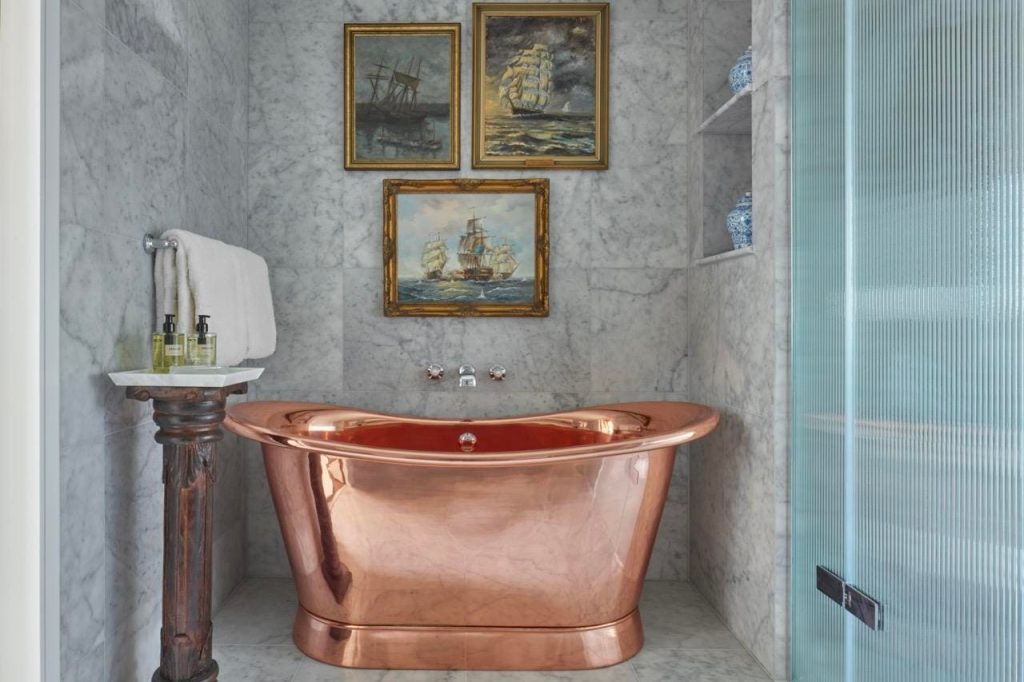James McDonald
The Sea Containers hotel occupies a historic Brutalist building in an enviable spot on the South Bank of the Thames, but it doesn’t seem to get the attention of other design-forward hotels in London. Which is a head scratcher, to be sure. The building itself was designed by American Modernist architect Warren Platner, and the hotel’s original interiors were by Tom Dixon’s Design Research Studio (it was his first ever hotel project). For over a decade, the intriguing property — with 354 rooms, three restaurant/bar options, a cinema, and a spa — has been an IYKYK situation. Which is how regulars would love to keep it. But the tides are turning and the debut of four new over-the-top-in-the-best-way suites are thrusting this notable introvert into the spotlight.
The lobby of the hotel boasts a dramatic, 223-fppt-long curved copper wall meant to resemble a ship’s hull, complete with 160,000 rivets.
Niall Clutton
“Everything in the hotel has a story. Entering the lobby is like arriving at a shipyard before going on your trans-Atlantic voyage, and all the rooms were designed to be cabins,” noted Jacu Strauss, creative director of Lore Group, operators of this property, as well as the Pulitzer in Amsterdam and the Riggs in Washington, DC. “We wanted to add to the story. I looked back at key moments in trans-Atlantic travel over the last 125 years and there were, to me, four distinct eras of sea travel that correlated to interesting shifts in design, society and engineering.”
The four eras Strauss identified were: Edwardian, Art Deco, Mid-Century Modern and the 1980s; he combined eight standard rooms on the 15th floor to create the four suites representing these eras, each with a bedroom, sitting room, bathroom and powder room. (Fun fact: as a young architect/designer, Strauss was employed by Tom Dixon and worked on the original designs for this very hotel). Red lighting becons those walking down the red-carpeted corridor towards these suites; each has a unique door that hints to what lies behind.
The Edwardian Suite
The Edwardian Suite.
James McDonald
“The Edwardian era was the first time travel became recreational. Ships were engineered like never before, and this was celebrated fully through decadence, elegance and grandeur,” explained Strauss. His Edwardian Suite features a 120 year-old kidney-shaped desk, artwork from that era including a large painting of a cruise liner at sea and even a plaque featuring the profile of King Edward VII, who, Strauss notes, is the era’s namesake.
James McDonald
An antique oak cabinet in the bathroom is styled with ships in a bottle – “a playful and nostalgic surprise.” At the time of this writing, this particular suite was proving to be a guest favorite overall. Strauss postulates that perhaps nostalgia plays a role: “this reminds a little bit of something I saw or experienced when I as younger.” Or it could be the large copper soaking tub, set in a marble niche clad with vintage photos of sailing ships. Or the view of St. Paul’s Cathedral, just across the way.
The Art Deco Suite
©James McDonald
“Art Deco was the period between the two world wars, a celebration of style and simplicity, with strong forms combined with rich textures. People built their homes to look like big ships, for example.”
James McDonald
Strauss spent months sourcing treasures for the room, including vintage glassware appropriate for that era, as well as the reproduction full scale diving helmet in the powder room, and the gleaming nickel bath tub with a Tamara Lempika-inspired portrait above.
©James McDonald
Strauss recalled that he “personally collected [the artwork] from the seller in North London and drove it myself in my convertible Mini. Definitely got a few looks on that journey!”
The Mid-Century Modern Suite
James McDonald
The mid-century modern era, Strauss notes, dates to the 1950s, but it could be argued that it continued through a portion of the 1970s as designs with mass appeal and staying power. “It was a stylistic and social revolution driven through what was happening in the US in particular. And this included a new social environment of recreation, practicality, and technology.”
James McDonald
Many iconic pieces from that era combine certain shades of wood, laminate and steel – three materials Strauss employed to great effect. There are distinctive pieces by USM Haller, a Swiss-based furniture company, vintage glass and ceramic pieces, a color blocked rug, lighting that nods to George Nelson and Noguchi and sideboards that Strauss repurposed as bathroom vanities.
James McDonald
The Dynasty Suite
James McDonald
The fourth and final suite is the Dynasty Suite. Which celebrates everything ‘80s but, Strauss is quick to point out, “not the dress up party 80’s…. the bold and confident and very decadent 80’s. Bigger was better and this applied to ocean travel. Recreational cruise programs became more diverse, ships got bigger, focused on having a good time and exploring even more exotic destinations.”
James McDonald
Those who remember the iconic television show will appreciate the color palette, the curvaceous furniture (those scallop chairs were sourced f the U.S. and reupholstered), the spot-on accessories, the gold-toned swan faucets in the bathroom, and that fabulously over-the-top headboard.
James McDonald
James McDonald
Collectors take note: Strauss observed that of all the suites, items for the Dynasty era were the hardest to find. He predicts an ‘80s interiors comeback, advising interest parties to “snap up post-modern 80’s items!” tout de suite.
Sea Containers London, 20 Upper Ground, SeaContainersLondon.com
Sea Containers London occupies a 1974 Warren Platner-designed building on the Thames
Niall Clutton

